How To Paint Pond Water In Acrylics
Always Wanted To Learn How To Paint H2o Realistically?
My process teaches you how to paint water, and really come across water, in a whole new way.
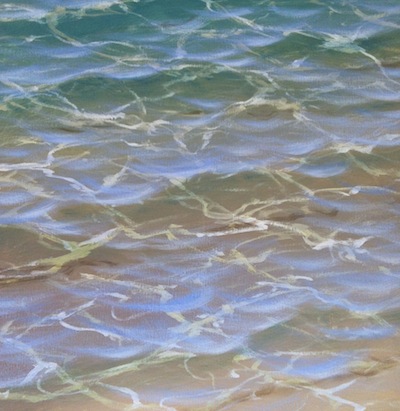
Water is one of the nearly compelling subjects to paint, and nevertheless it can all end so desperately. The problem often is; where to outset?
I wrestled with creating the illusion of fluidity, clarity and some semblance of realism for a long time.
Somewhen I discovered a way of looking at h2o that allows us to recreate information technology in almost whatever circumstance.
The play a joke on is to intermission it downwards into manageable pieces, rather than try and paint it in its entirety. When you empathise how these pieces affect each other, learning how to paint water becomes much easier. You will find that you may look at water in an entirely different way.
Before we start, however, there are a couple of things I need to say. When painting something realistically at that place are two overriding skills needed, and especially when learning to paint h2o:
- Firstly, your technical ability, or your ability to utilize a brush, mix colour etc.
- Secondly, your ability to observe, and find the item necessary to create something that is convincing.
This tutorial is primarily about the "details" I use when painting h2o.
The next point is that this strategy is not the only way, nor mayhap the all-time style. But it works brilliantly for me, and hopefully volition for you, as yous learn how to represent water in your paintings.
Now that'south out of the way, let's get into information technology!
When learning to pigment water realistically, information technology is important to consider that the appearance of water is made up of 4 elements:
- The substrate (or bottom. No, non bottoms. This is how to paint water - not how to pigment figures).
- The colour of the h2o (determined by what is suspended in information technology)
- The surface of the water
- The calorie-freeNow we'll await at each of them in a piffling more detail:
| The Substrate |
|---|
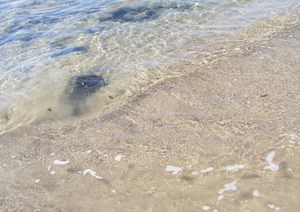
The substrate could exist made up of beat out, gravel, coral, river stones; or if you lot live in a major city, car bodies and small calibre pistols.
Any the substrate, depending on the other elements, you volition be seeing a lot of it, or not much. Side by side trip to the beach, lake or swamp, check out how much of the substrate you can see.
| The Colour of The Water |
|---|
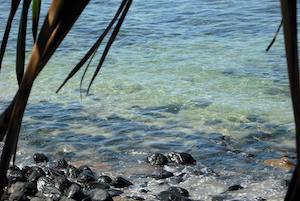
This is determined by the sediment it is carrying. Subsequently rain, chances are that the water in your local river will exist tainted with sediment. After a lot of rain, sometimes there is and then much sediment that seeing the bottom is nigh impossible (unless the water is very shallow).
Plainly, non much sediment and clean h2o will minimise the impact that the colour of the water has on the substrate.
A lovely example is a lake in my area that is stained with a tannin from the copse around it.
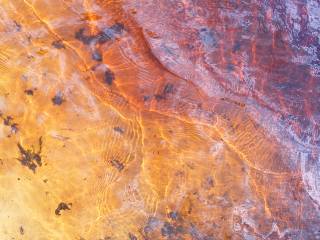
Information technology has a fantastic reddish tinge to it, and is as dark as cola (arguably better for you than cola, despite the number of pocket-sized children that swim in it). When you look at the h2o in this lake it is very easy to see how thecolour of the water impacts the colour of the substrate.
| The Surface of The H2o |
|---|
This is probably the most important chemical element of all when learning how to paint water. The surface of the water is affected past many dissimilar things, ripples caused by wind, children splashing, boats, etc. You get the picture. The interesting thing almost the surface of the water, is that it impacts the appearance of water in two ways:
- Refraction, and
- Reflection
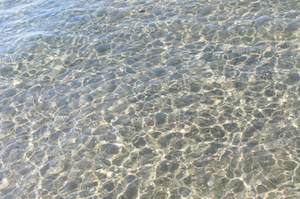
Refraction
When water moves, information technology concentrates and dissipates light. Each wave, whether minor or large, will form a lens. Lite will be concentrated - forming that wonderful pattern that is thrown on the bottom of a puddle just afterward everyone has got out.
This issue occurs to varying degrees depending on how rough or smooth the surface is, and the force of the light. Less light = less refraction. More than light = more refraction.
We'll go into some painting techniques to create this outcome a niggling subsequently.
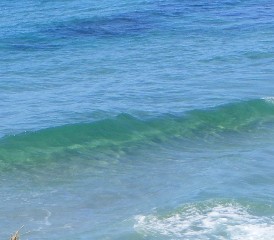
Reflection
Each time awave rises, big or pocket-size, it reflects light. Any is backside the wave (relative to you) needs to be represented - regardless of the substrate, and regardless of the colour of the water.
A sunlit bluish heaven will show a sunlit bluish reflection. A beautiful sunset will reflect the cute dusk. That's all fairly obvious, but........ you may not take considered thateach time a wave forms, its face up creates a window. This allows you to encounter nether the surface (if the water is relatively clear).
Recall of theface of the wave towards y'all equally a window to under the surface. Think of everything else as a reflection of the light.Windows and mirrors.
I've probably made all this audio more complicated than it is just I hope to bear witness youeasy means of representing and painting the elements.
| The Calorie-free |
|---|
Thankfully we have just covered it. The light we come across on the h2o is directly impacted by the surface. Read to a higher place Refraction and Reflection sections again for a refresher on light.
An Practice!
Here is a painting exercise to aid us understand how water appears, and assistance y'all along in your painting journey.
TIP: H ave a few bare canvases effectually to test things on. I volition often paint an attribute of a painting on a split up sheet, then I know what I am doing before I commit it to a "serious" slice.
Set up a pocket-sized sheet and imagine that we are painting a sandy lesser (Once again? Really. How old are yous people? Yous know I meant substrate - this is painting water recall!) in shallow articulate water on a sunny twenty-four hour period. I use Artists quality acrylic paints by Blush Australia, Atelier Interactive and Atelier Gratuitous Flow.
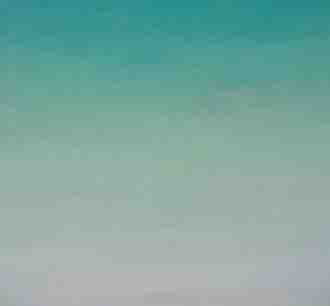
Now we want to correspond each of the elements. We need to do this efficiently. We could just paint the substrate. It tin be boring to add layers of thin glazes to correspond the color of the water. We want to make the process of learning to paint h2o every bit simple as possible. It is much easier to pigment the substrate (sand for example) and create the illusion of differing depths with a gradation of colour.
Preparing the sail to this bespeak will railroad train yous in a very important skill. Painting a controlled gradation of colour/s is something many achieved artists struggle with. Employ a largish brush (ie size 8 or 10) and plenty of paint.
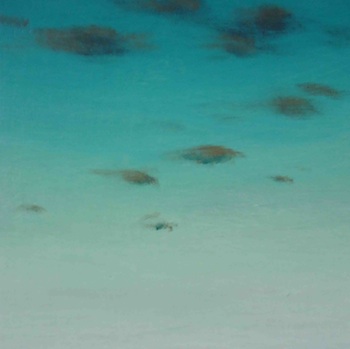
The next office of this process is to represent the refraction of lite on the substrate. This is not an easy thing, yet a technique I have developed makes information technology easier. Y'all need to allow your brush to be controlled in an uncontrolled style. What the? Information technology volition make sense! Hope!
Discover a spare canvas to practise this skill. Grab a small chisel brush size 4 or half-dozen and load it with pigment. Make this blueprint - you volition demand to roll your brush between your fingers whilst pushing it backwards and frontward horizontally, creating extremely loose & wobbly diamond shapes. Allow the brush to brand its own mode, to a certain extent.
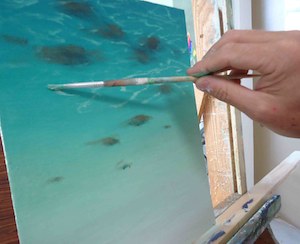
This represents the low-cal which is refracted by the surface of the water, downwardly onto the substrate. Be enlightened that if you wish to create the illusion of distance then you must adjust the size of the "openings" equally they recede into the distance. Important - you need to be aware, when applying this technique to a "proper" painting, the refraction volition change colour as information technology goes into deeper water.
When yous accept experimented with this and feel comfortable with the results, you can then utilize this to your exercise. Hopefully y'all should have painted something similar this.
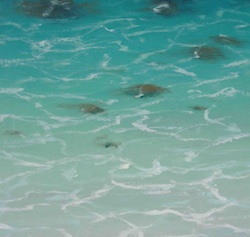
Now for the surface and the light. Thankfully, in this how to paint h2o exercise, this is relatively easy - both elements can be painted using ane technique.
When using acrylics, the adjacent role is easier if your previous work is dry. Make certain you have a very dry brush (size 6 or viii) with the tiniest amount of pigment and brand a series of very shallow W's. These West's stand for small waves and are where the calorie-free coming from behind the wave is reflected to your center.
They seem to sit higher up the substrate creating the illusion of depth.
Practise not pigment them neatly and in rows. They will look like a properties for a pantomime. They should look something like this.
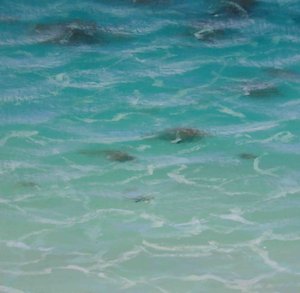
That's it! Y'all have represented all of the four elements.
Whoa, concord on at that place. You may have noticed that the existent world does not e'er look like your exercise. Aye, its true. Information technology doesn't. This is where you lot get homework. Get out into the world and find each of these elements. Identify each one split up from the others. Identify the shapes and colours associated with each element.
Then, beginning looking at each of the elements and observe how much of the substrate is visible because of the colour of the water. Look at how much is visible considering of the surface of the h2o and by default, the light. Spend some fourth dimension noticing how much each of the elements affects the others in the forenoon, at sunset - and at other times of the day.
Build your observational skills and watch your paintings improve. Having but four elements to work with, gives you a adept solid base of operations to start.
If you notice yourself stuck and want some visual assistance, I go into it in much more than detail in my DVD:

Water Fundamentals.
My 3-pack of DVDs is now bachelor in hard copy and downloadable format - click here for more than info on my iii-pack (cheaper than ownership them 1 at a fourth dimension!).
Happy painting!
Learning how to paint h2o can (and should) be fun!
Dig in, its a contact sport.
For more tips, special offers and inappropriate humor, please subscribe to our monthly e-zine,Acrylics Anonymous.
Subscribe Hither:
Top of How to Paint Water
Dorsum To Painting Tutorials
Back to Explore Acrylic Painting Home Page

How To Paint Pond Water In Acrylics,
Source: https://www.explore-acrylic-painting.com/how-to-paint-water.html
Posted by: lopezbricip1961.blogspot.com


0 Response to "How To Paint Pond Water In Acrylics"
Post a Comment